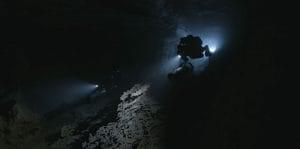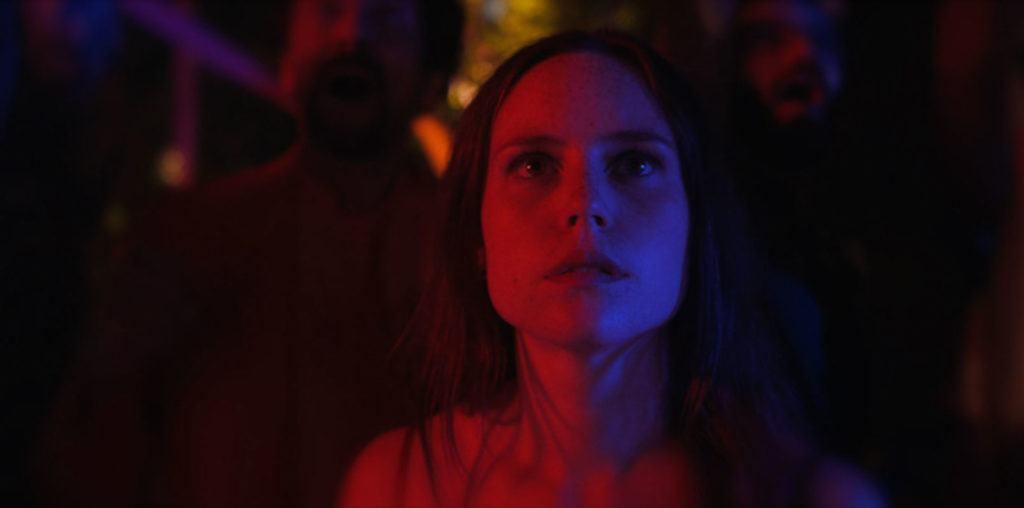
One of the most demanding extreme sports on earth is cave diving. The sport is not necessarily more dangerous than other pursuits, but it is absolutely unforgiving of carelessness and neglect. Mitigated risks can become life threatening issues in seconds. Caves often contain sand, mud, clay, silt, or other sediment that can reduce underwater visibility in seconds when stirred up. Caves can carry strong water currents.
Cave divers do it because they need to test themselves under the most extreme conditions in the most remote places. When it’s going well, it can be the most serene “away from it all” imaginable but it can go pear-shaped instantly. This is not an endeavor for a person with any issues like claustrophobia or any emotional demons as they will chase you to the depths and ruin your day at 130 meters.
Diving Into the Unknown is a documentary of events on February 6, 2014 when a terrible accident happened 130 meters below the surface in a deep underwater cave in Plurdalen, Norway. Two divers drowned and three miraculously survived.
“Norwegian police declare the site closed to diving and after some attempts to retrieve the bodies call off the effort as being too dangerous.”
The initial project to film the divers was just to get video of the traverse from the Plura lakeside to the Steinugleflåget dry cave. The crossing is 2 kilometers and descending to 130 meters at temperatures of 3 degrees Celsius. Specialized equipment, training, and experience are crucial to a safe traverse.
There are numerous risks: The water is cold, barely above zero in winter: a small tear in a dry suit and you’d die from hypothermia. The total darkness (what do you do if the light fails?), the great depths and decompression sickness. Gas narcosis at that depth is also always a possibility where as you descend you feel drunk while breathing gas under pressure. This effect is measured in “martini’s” you feel like you’ve had as depth increases.
The team that began the initial dive had done this kind of dive before and it was not the most challenging cave system they had explored together but even when you have the right people, the right equipment, and the right plan, things can still go wrong.
Patrik Grönqvist, Jari Huotarinen, and Jari Uusimäki were the team members on the initial push into the cave. First Patrik and Jari H. went under water. Two hours later the second team follow the same path.
After entering at the lake two divers made their way to the beginning of the ascent to the dry cave, and at 110 meters depth Jari Huotarinen had one of the worst possible problems in the cave: he got stuck with all his gear in a narrow passage. Struggling to free himself caused his carbon dioxide levels to ramp up quickly and his friend Patrick spent the next 10 minutes watching him die, unable to help him.
The second team ran into the dead diver and had to push past him. Panic set in and bad decisions led to people being injured by decompression sickness (also called the bends). With divers bent, once out of the water they must climb out of the dry cave, 250 meters to cross, 90 meters elevation rise to the exit. Two other members of the second team encountered the body, one panicked,the other (Jari Uusimäki) also dies in the deepest part of the cave. Kai Känkänen turned back from that point and made his way back to the Plura entrance, spending a total of 11 hours in the water.
The Norwegian police are called in and declare the site closed to diving. They sent in their own dive team and after several attempts to retrieve the bodies called off the effort as being too dangerous.

“Even when you have the right people, the right equipment, and the right plan, things can still go wrong.”
Then it gets weird: the surviving team members gather and devise a plan two months later to come back and reclaim the bodies of their friends. The bulk of the documentary is about their recovery effort.
This film is more terrifying than any horror flick. Sudden death is ghastly when minor problems rapidly cascade into a fatal situation.The entire group whose training, temperament, and experience have taught them to regulate their emotions is in shock after the accident and emotionless as they plan the rescue.
The cave footage is beautiful with the diffuse lighting and incredible visibility, it’s one reason they go: to experience the rare breathtaking beauty of these vistas firsthand. The movie is an intense look at the wild beauty of underwater caves and the people who insist on exploring them despite the danger.
Diving Into The Unknown (2016) Directed by Juan Reina. Starring Sami Paakkarinen, Kai Känkänen, Patrik Grönqvist, Vesa Rantanen.
8 out of 10


So powerful! I can’t wait to see it.